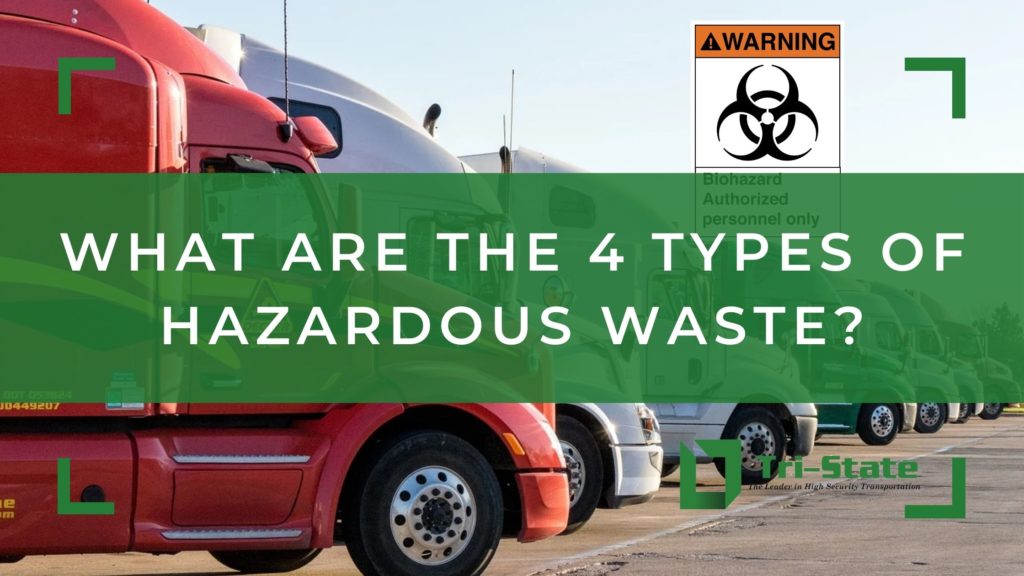Exploring the Different Categories of Hazardous Waste

Understanding the types of hazardous waste your business generates is essential to properly manage and dispose of waste. Failure to follow the regulations for storage and disposal regarding each type of waste can result in fines and liability.
Four Identifiable Classifications of Hazardous Waste
According to the Environmental Protection Agency (EPA), there are four classifications of hazardous waste: listed wastes, characteristic wastes, universal wastes, and mixed wastes. Below we summarize these hazardous waste categories.
1) Listed Wastes
- F-List Wastes — Represent non-specific source wastes, commonly called “manufacturing process wastes”, are wastes that are generated during manufacturing and industrial processes. A common example of an F-list waste is spent solvents used in cleaning operations.
- K-List Wastes — These are wastes that have specific industry sources. Pesticide and petroleum manufacturing industries both produce k-list wastes through their production processes.
- P-List Wastes and U-List Wastes — Both P and U-list wastes contain unused, toxic chemicals in their pure form. Pesticides and pharmaceutical products are considered P and U-list wastes.
2) Characteristic Wastes
Characteristic wastes are hazardous wastes that do not fit the requirements to be considered listed wastes. They are as follows:
- Ignitability — Ignitable wastes are hazardous wastes that are flammable with a flashpoint under 140 degrees Fahrenheit. Ignitable wastes can easily start fires if they are not handled and disposed of properly, making them hazardous substances.
- Corrosivity — Corrosive wastes are usually acids and bases or any substance that can melt through steel materials, rust, and decompose. Aqueous wastes with a pH greater than 12.5 or under 2 are considered corrosive wastes.
- Reactivity — Any wastes that are explosive or unstable under normal conditions is deemed reactive. These are usually gases that have high pressure or heat, but can be any waste that is capable of exploding.
- Toxicity — Toxic wastes are those that can be fatal when absorbed or ingested. Lithium-sulfur batteries are an example of toxic waste because they may cause death if consumed.
3) Universal Wastes
Universal wastes are also referred to as commonly-generated wastes or dangerous goods because they are commonly used products largely available to the public. Examples of universal wastes include bulbs, batteries, pesticides, and turpentine. The EPA classifies these goods so they do not end up in landfills like other waste.
Universal waste is broken down into 9 classes:
- Class 1: Explosives
- Class 2: Gases
- Class 3: Flammable Liquids
- Class 4: Flammable Solids and Substances
- Class 5: Oxidizing Substances and Organic Peroxides
- Class 6: Toxic and Infectious Substances
- Class 7: Radioactive
- Class 8: Corrosive Substances
- Class 9: Miscellaneous Dangerous Substances and Articles
4) Mixed Wastes
Mixed waste contains hazardous and radioactive components. The U.S. Department of Energy (DOE) classifies three types of mixed waste: low-level mixed waste, high-level mixed waste, and mixed transuranic waste. The treatment and disposal of mixed wastes vary depending on the type of mixed waste.
Importance of Proper Hazardous Waste Disposal
It is legally required that businesses properly handle and dispose of hazardous waste in accordance with regulations. This is necessary in order to protect the environment and prevent people from being exposed to potentially harmful substances. Failing to properly dispose of hazardous waste can have severe consequences for both the environment and the health and safety of individuals. It is important that businesses take the necessary steps to ensure that they are complying with these regulations and taking appropriate measures to safeguard the well-being of their employees and the community. Transportation of all waste needs to comply with the U.S. Department of Transportation Hazardous Materials Regulations. All shipments of hazardous waste are also required to display the appropriate hazardous waste placards.
Following the guidelines for the proper handling, transporting, and disposal of hazardous waste is a necessary part of protecting the environment and also helps protect people from exposure that can lead to harm and death.
